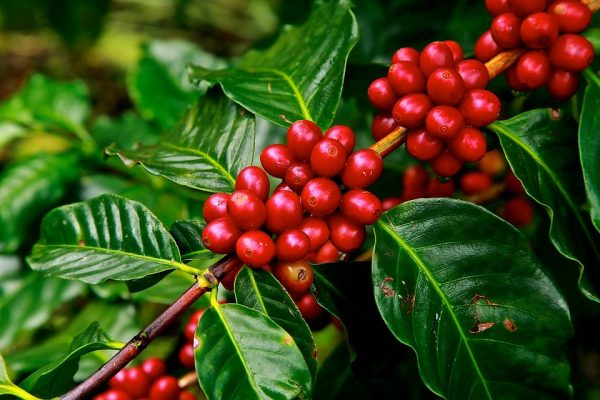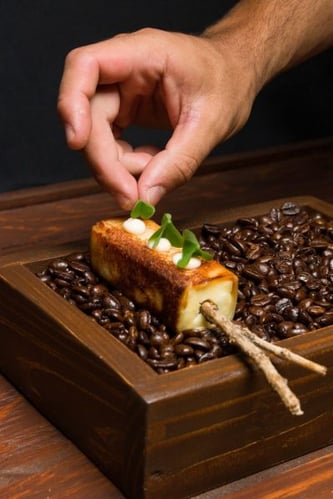Tuesday, October 1st, 2019.
In this Daily: Two Perspectives on Coffee in Costa Rica for World Coffee Day
Costa Rica is one of the world’s foremost coffee producing nations, well renowned for its exceptional quality and diversity of flavors thanks to its 7 distinct regions.
Today is World Coffee day, and both Chef Gilberto Briceño and Chef Saul Umaña offered an international perspective on the many uses of coffee, their favorite aspects of the coffee flavor, and how they’ve used coffee in their own cooking.
Chef Saul Umaña
Having trained in the Basque Country at Michelin-starred Kokotxa and plied his trade all around the world, Chef Saul Umaña now works as the head chef at Ponciana. His cooking draws from seasonal local ingredients, which makes the richly flavored Costa Rican coffee a versatile aspect of his cooking.

TD: How have you used coffee in your cooking in the past?
SU: I have used coffee in various preparations. Coffee gives us many properties for flavor in marinades and at the same time to crust meats. In turn it is also a great ally in the preparation of sauces. I always remember making a beef tenderloin with coffee and orange crust that is delicious and always surprises.
TD: What particular aspects of the coffee flavor are most interesting to you?
SU: Coffee is a whole world of flavor, like wine. Everything will depend on the height at which it was grown and harvested, and the toaster plays an important part in the process since according to its different types of roasting it will have a different flavor. I think this makes it wonderful and very versatile.
TD: During your travels around the world, where have you seen coffee used in the most interesting/best ways?
SU: During the trips I have experienced many very good uses of coffee, for example from fertilizers for crops to drinks and sweets made with coffee. But well, Costa Rica is a very good producer of cups of excellence. Here I have visited farms and I have met collectors, roasters and baristas who have provided me with valuable information on the many ways to use Costa Rican coffee.
Personally, I love a drink that I tried on my last trip to Guatemala called carajillo that consists of a black coffee with coffee liquor. It is a delicious drink for rainy afternoons and also a great digestive at the end of a meal.
 Ripe Coffee Beans | PC: Commons
Ripe Coffee Beans | PC: Commons
Chef Gilberto Briceño
Gilberto Briceño has trained in the kitchens of Spain, Brazil, and Sweden among others, including Michelin-starred Fäviken in Sweden. One of his goals in cooking is to take local Costa Rican ingredients and elevate them to attract people from many different countries, and one of the many products he uses is Costa Rican coffee.
TD: Are there any interesting ways you’ve used coffee in your cooking in the past?
GB: Sí, I had a favorite meal before that was focused on the different phases of coffee ripening and roasting throughout the meal.
We had green coffee bean (unripe) for dressings and Kombucha, and we had red coffee bean (ripe) for sweets and spreads. Then we had dehydrated coffee skin in teas and cold brews. We followed that with toasted coffee (as we usually drink it), then finished with coffee desserts & sauces. We even used coffee beans to plate dishes on it, and the coffee stick as a skewer.

TD: What particular aspects of the coffee flavor are most interesting to you?
GB: I love the terroir. Like in the world of wine, coffee tastes different according to the land where they grow, so you get all sorts of different flavors.
TD: During your travels around the world, where have you seen coffee used in the most interesting/best ways?
GB: In Fäviken, we used to end the tasting menu with Coffee from Guatemala. In Azurmendi, we used to end the tasting menu with Coffee from El Salvador. When I was in Denmark, they used to have different coffee desserts.
My favorite/creative way to use coffee is to ferment the left overs to create a "soy sauce". We use the coffee that stays in the espresso machine and age it to make the sauce, a version that is a bit more english with a strong umami flavor. Found it on the Noma Cookbook and I love the Costa Rican version.
Taste them For Yourself
It’s possible to taste both Chef Briceño and Chef Umaña’s perspectives on cooking with coffee when you visit Las Catalinas.
Chef Umaña’s seasonal menu at Ponciana features a coffee-stick roasted pumpkin with coriander kimchi and a preserved citrus bok choy, a dish that brings the subtle flavors of coffee stick in as a complement. Chef Briceño’s in-home dining as part of Bahía group, as well as his pop-up dinners, integrate the flavors of coffee in different ways. As a result, these regional flavors can make appearances at any point in the meal.
Just two of the many ways to experience the flavors of coffee in Costa Rica.